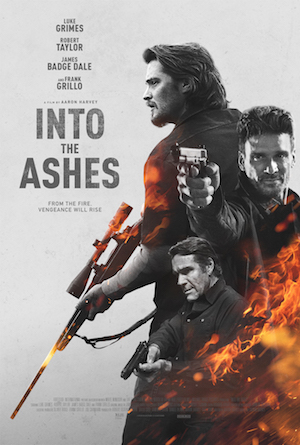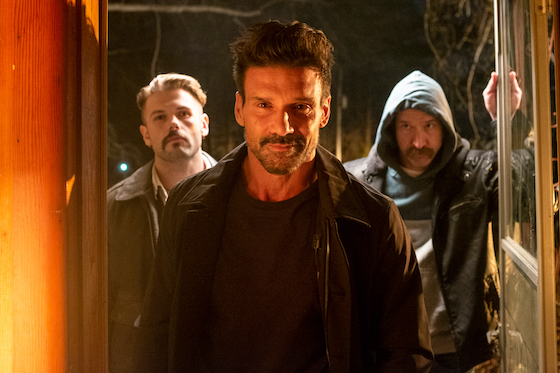

[Rating: Minor Rock Fist Up]
A slow-burn postmodern western-noir thriller with just a tad more style than substance, Into the Ashes delivers when it needs to, and revels in the nihilistic burdens of modern small-town America. The story of a reformed baddie whose retreat into the arms of a loving woman is hijacked by past demons, the film gets a lot of things right, from the composition of its leads, its cinematography, and even the rural dialect it deploys throughout. Into the Ashes pulls up short in its third act, however, when its ambition outruns its abilities, and the good work of the previous hour fizzles out a bit.
The film opens in an anonymous southern U.S. locale in a nebulous time period that is likewise not made clear. The twang in the voices of the characters points towards an Alabama or Arkansas milieu, and the noticeable lack of cell phones yet mostly modern automobiles likewise hints at a late-twentieth/early-twenty-first century setting. The audience meets Nick (Luke Grimes), a happily married blue collar worker whose life revolves around his loving wife (Marguerite Moreau) and his passion for outdoor, country living.
Although it’s not stated outright, the script does a good job setting up a subterranean conflict between Nick and his wife’s father, the local sheriff, Frank (Robert Taylor). Nick appears to have a past that he’s taken refuge from by way of his marriage, and while it seems he’s kept most of that a secret, Frank’s lawman spidey-senses keep him on edge about the arrangement. When the film cuts to the parole of Sloan (Frank Grillo), whose only objective following his release is to track down Nick, it becomes clear that the sheriff’s suspicions are well-founded.

When Sloan and his new crew do catch up with Nick, the consequences are brutal, and force Nick back into his abandoned lifestyle to make things right. In this way, Into the Ashes is a fairly straightforward revenge flick, with many of the western tropes familiar to fans of The Outlaw Josey Wales or even Unforgiven: yet this is more noir than western, reveling in notions of cynic fatalism. The film is playing with ideas familiar to the western genre, what with its focus on a reformed criminal who has hung up his guns only to be pulled back into the life for one last job, but the line between the “good” and the “bad” guys is deliberately fuzzy, here, and doesn’t subscribe to the traditional western ethos.
Into the Ashes skims on the surface of this world, choosing again and again to sidestep exposition of trivialities like time and place for character work. Writer/director Aaron Harvey isn’t interested in bogging down his story with specifics like the year or locale, and throughout most of the picture, these choices pay dividends, for it forces the audience to commit to the characters (primarily Nick and Sloan), pulling one into the crocodile-like death-roll taking place between these two. Indeed, when a beast has something in its jaws, and the terrible spinning begins, there’s little concern for anything else.
When the film maintains its laser-like focus, and pushes itself forward with linear deliberation, it works splendidly. Although shit doesn’t hit the fan conflict-wise until the movie is well into its second act, the time it has spent with Nick, Sloan, and Frank, pulling out the conflict and angst that’s built up between them, provides the urgency needed to propel the second half forward. The waters begin to cloud up when the conflict manifests itself, however, and the script (and Harvey) seem to have trouble harnessing the raw power driving everything forward. There’s violence and action in the picture’s final act, to be sure, yet it is often fragmented and incomplete, offering the audience only a peek at the promised resolution of things.
When No Country for Old Men did this, it was as a commentary on the futility of struggle in the face of inevitability, and the insignificance of “heroes” in a world where such characters have become painfully obsolete. Into the Ashes wants to have this cake and eat it too, however, sidestepping resolution, if only for a time, as a device to keep its audience invested. In other words, it feels more like a parlor trick, here, and less of a deliberate choice to heighten existing themes.

It’s not a deal-breaker by any means, though. There’s a lot to enjoy with this one, and even more to admire in terms of the craft involved in its execution. The way cinematographer John W. Rutland uses the camera to tell silent stories (Sloan’s walk out of prison, for example) does as much work telling the tale of Into the Ashes as anything spoken. The sound design is likewise impeccable, with the action scenes and near-silent moments alike (like sheet plastic flapping against the unfinished construction of a cabin window) communicating as loudly as any dialogue.
It all works, and despite any deficiencies in the resolution of matters, the effort as a whole is strong. Compelling performances by Grillo, Grimes, Taylor, and James Badge Dale as Nick’s ride-or-die buddy, Sal, lift the whole effort. More than anything, Into the Ashes is an encouraging example of steady directing by Harvey, who is worth keeping an eye on going forward. Any missteps can be forgiven as evidence of a learning curve, which should smooth out over time, and keep future projects hot without crumbling into the ashes.





Comments on this entry are closed.